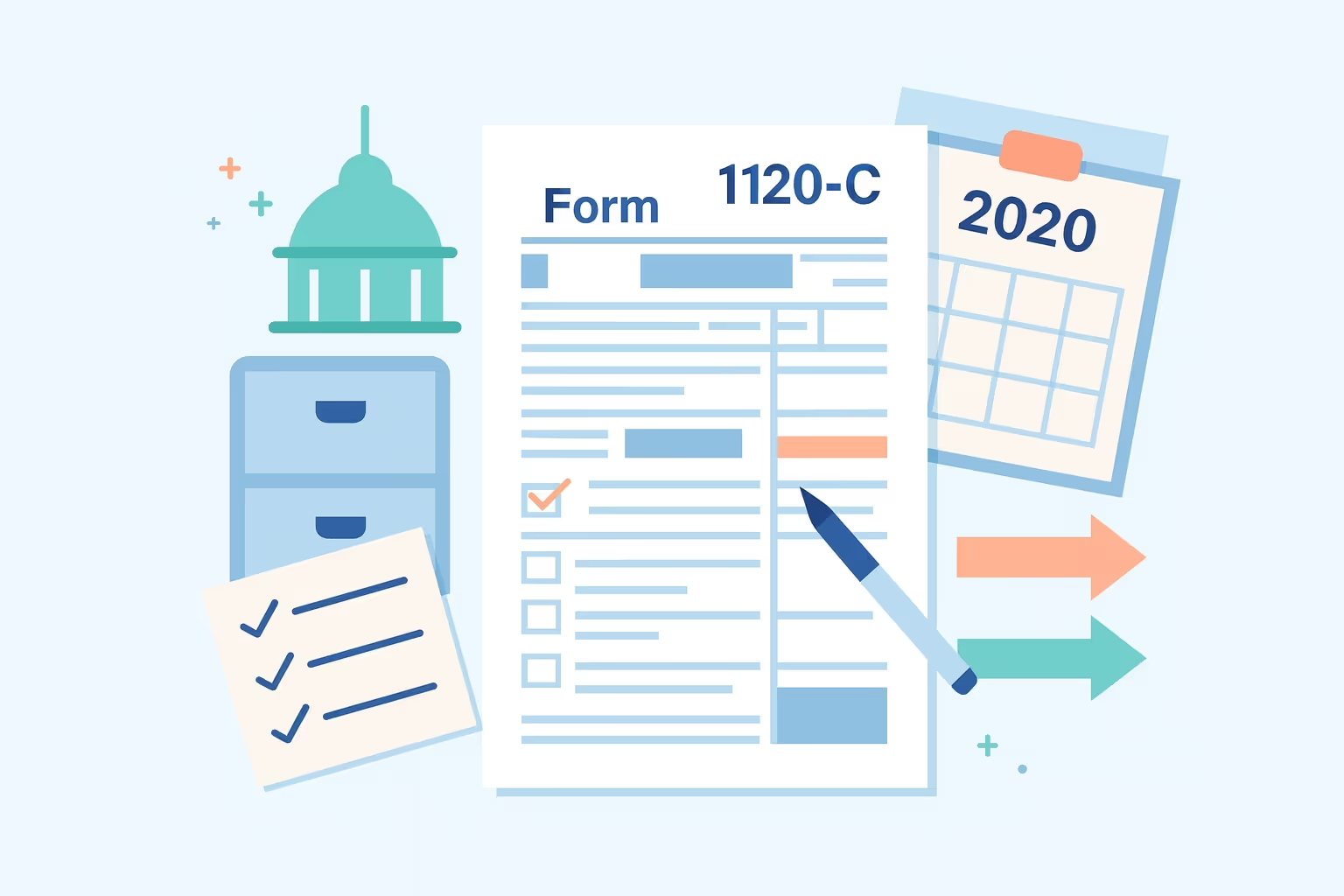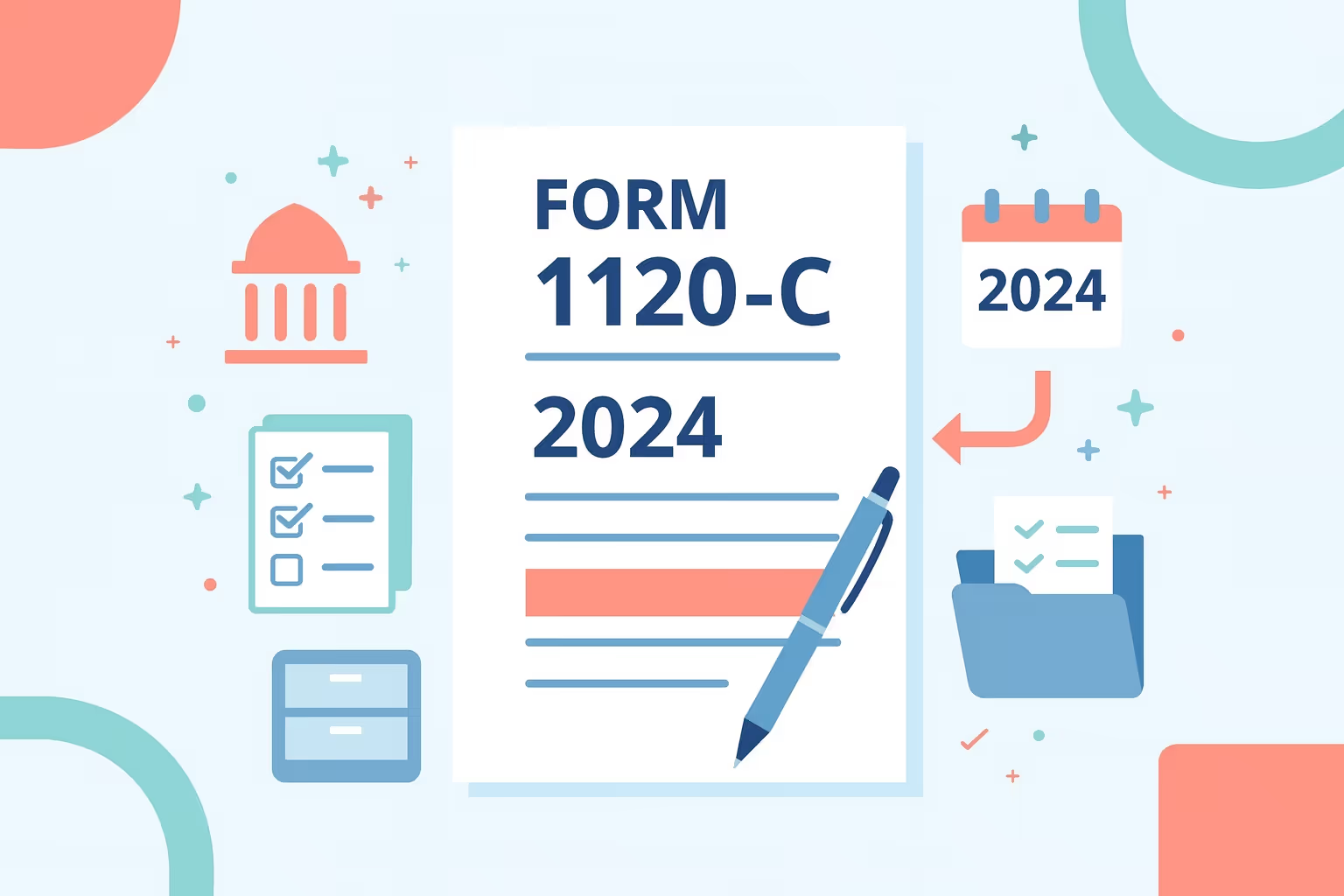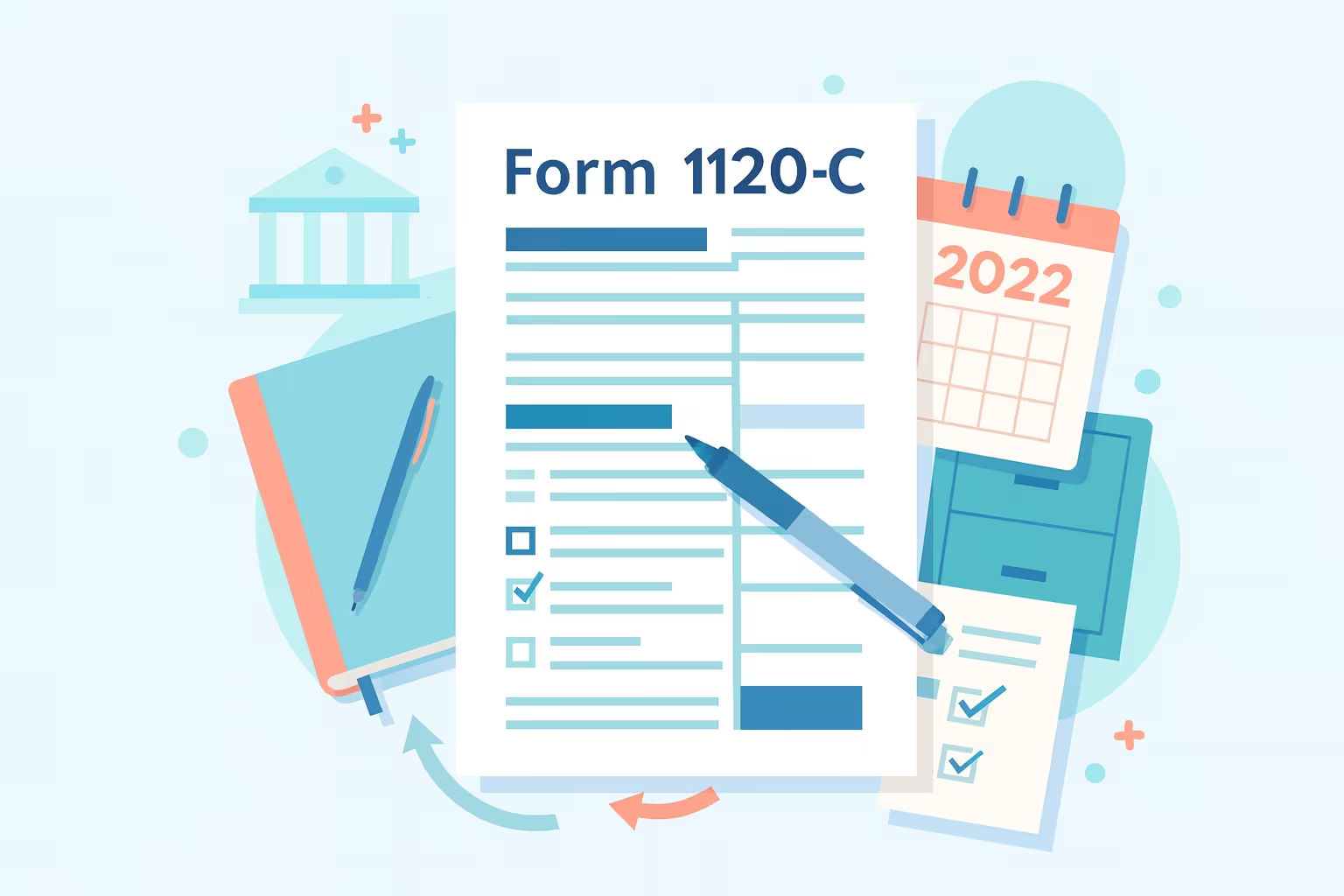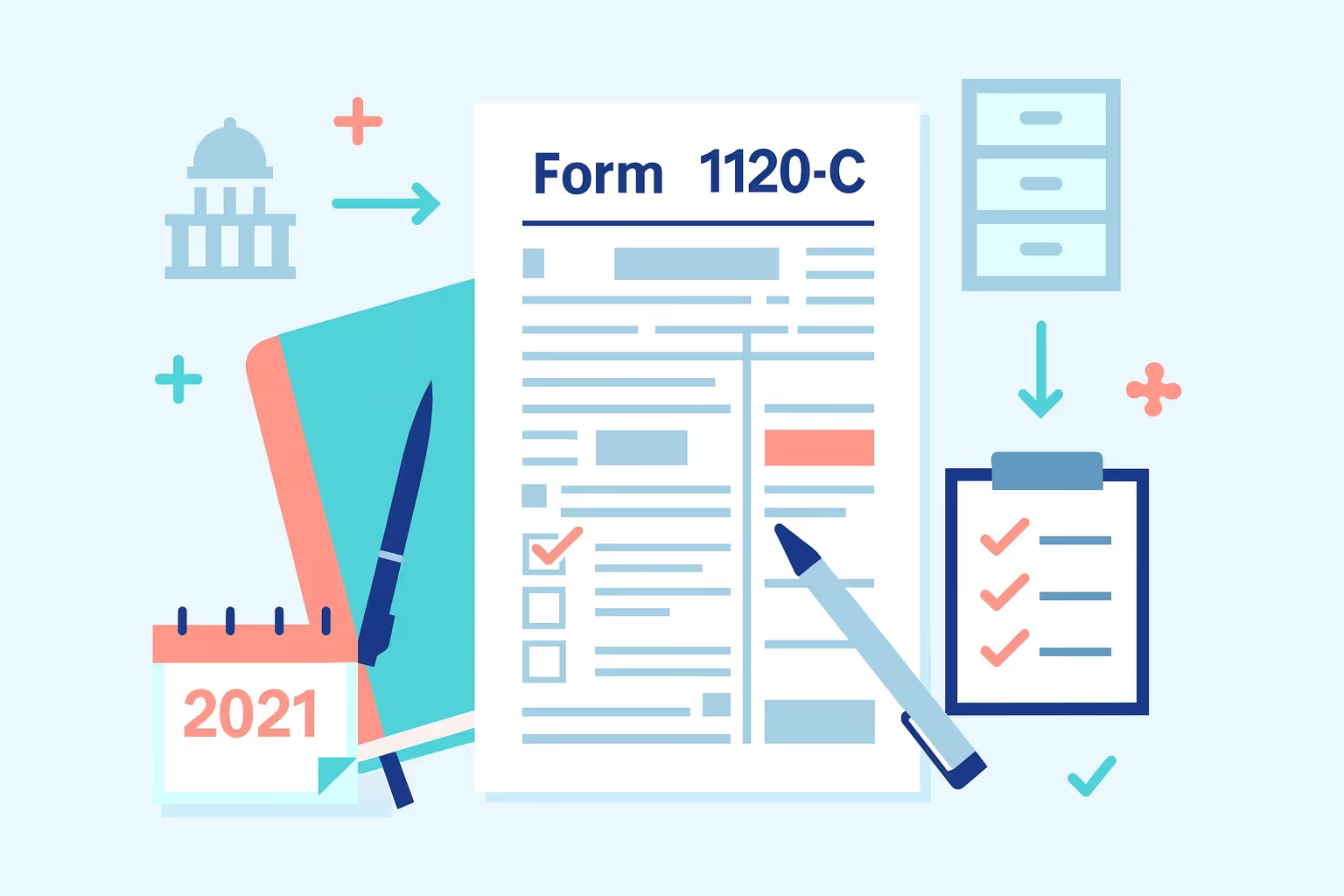How to File Federal Form 1120-C for Tax Year 2020

According to the Internal Revenue Service, corporations that file late or make mistakes on their corporate tax returns risk penalties that can add up to thousands of dollars. For cooperative associations, the challenge is even greater: filing federal Form 1120-C for tax year 2020 requires careful attention to patronage versus nonpatronage income, special deductions, and cooperative-specific schedules that most standard corporations never touch.
Many cooperatives underestimate the complexity of this filing. Misreporting taxable income, overlooking allowable deductions, or misclassifying gross receipts can delay refunds and create unnecessary disputes with the IRS. Errors also increase the risk of triggering penalties for underpayment of estimated tax or inaccurate reporting of income tax liability. What may seem like a simple oversight could cost members through reduced patronage dividends or unexpected tax bills.
Filing accurately and on time is a compliance requirement and a financial safeguard. Cooperative associations that prepare early, use electronic filing when possible, and follow IRS instructions carefully reduce the likelihood of mistakes and penalties. For the 2020 tax year, changes in tax laws, COVID-19 relief provisions, and temporary adjustments created even more opportunities for error. This guide will provide clear, authoritative steps to help you confidently complete your cooperative’s income tax return while avoiding costly delays and penalties.
Understanding Federal Form 1120-C for Tax Year 2020
Federal Form 1120-C for tax year 2020 is the income tax return designed explicitly for cooperative associations. Unlike a standard corporate income tax return (Form 1120), this filing recognizes the cooperative business model, where income may be generated from both members (patronage) and non-members (nonpatronage).
The Internal Revenue Service (IRS) requires cooperatives to use this form to report their company’s income, deductions, credits, and tax liability. This ensures accurate gross and taxable income reporting that must be allocated correctly.
The form plays a dual role for cooperatives. It allows the organization to report net income to the IRS while also documenting patronage dividends and per-unit retain allocations that are essential to cooperative operations. Without using Form 1120-C, these associations cannot correctly account for their unique tax treatment.
Who Must File?
The IRS requires any corporation operating on a cooperative basis under section 1381 of the Internal Revenue Code to file Form 1120-C. This includes:
- Farmers’ cooperatives: Exempt (under section 521) and nonexempt organizations must file in this cooperative, regardless of whether they report taxable income.
- Marketing, purchasing, and service cooperatives: These must file even if they distribute most of their net operating gains back to members.
- Certain housing cooperatives: In limited cases, housing cooperatives that operate as corporations may also need to submit this return.
However, some organizations do not use this return. For example, insurance companies, mutual savings banks, homeowners associations, and certain foreign corporations file different corporate tax returns. Domestic and foreign corporations that qualify under subchapter T but are not cooperative may also be exempt from this form.
Key Features of the Form
Form 1120-C contains unique schedules and reporting lines that distinguish it from other federal returns:
- Patronage vs. Nonpatronage Income: Cooperatives must allocate income and report income separately between business done with members and non-members.
- Special Deductions: These include net operating loss deductions, charitable contributions, and other necessary adjustments that lower taxable income.
- Schedules G and H: These sections require accurate reporting of gross receipts, patronage dividends, and per-unit retain allocations.
- Detailed Balance Sheets: Cooperatives must provide financial statements reflecting total assets, liabilities, and equity as part of the tax reporting process.
These features ensure that cooperative associations meet IRS expectations while protecting themselves from penalties tied to inaccurate reporting.
What Changed in the 2020 Tax Year
The 2020 tax year introduced special rules to help businesses survive the pandemic. Cooperative associations filing federal Form 1120-C for tax year 2020 had to account for new credits, including the employee retention credit and employment credits tied to COVID-19 relief.
These credits reduced income tax liability, but they also created reporting challenges. Wages used to calculate credits could not be reused to claim other deductions, making accurate reporting essential to avoid penalties.
Business interest expense rules also shifted. Many cooperatives faced limits on the amount of deductible interest under the Internal Revenue Code, but temporary relief increased the percentage of income that these expenses could offset. Cooperatives were required to reflect these changes in their income tax return, ensuring taxable income reported aligned with IRS guidance.
Expanded Deductions
The IRS also allowed broader deductions in 2020. Charitable contribution limits were temporarily suspended, meaning cooperatives could claim qualified cash contributions without being capped at 10% of taxable income. For specific donations of food inventory, deductions increased to 25% of net income, making these contributions more valuable from a tax reporting perspective.
Net operating loss deduction rules also changed. Losses from 2018, 2019, or 2020 could be carried back to five years, allowing cooperatives to adjust prior returns and recover previously paid taxes. This adjustment helped cooperatives offset financial losses and stabilize cash flow during an uncertain year.
CARES Act and Jobs Act Impacts
Two major laws shaped the tax year 2020: the Coronavirus Aid, Relief, and Economic Security (CARES) Act and the Tax Cuts and Jobs Act (TCJA). These acts impacted corporate income tax return filings, altering how taxable income and net operating losses were treated. Cooperatives that ignored these changes risked reporting errors and reduced eligibility for valuable tax credits.
Key Differences Between 2019 and 2020 Tax Rules for Cooperatives
Business Interest Expense
- 2019 Rule: Deduction limited to 30% of income.
- 2020 Rule: Increased deduction limit to 50% of income.
Charitable Contributions
- 2019 Rule: Capped at 10% of taxable income.
- 2020 Rule: Limits suspended; higher deduction allowed for food inventory contributions.
Net Operating Loss (NOL) Deduction
- 2019 Rule: Only carryforward allowed.
- 2020 Rule: Carryback permitted for up to 5 years.
COVID-19 Credits
- 2019 Rule: Not applicable.
- 2020 Rule: New credits available, including employee retention credit and sick leave credit.
Step-by-Step Guide to Filing Form 1120-C
Filing federal Form 1120-C for tax year 2020 is not simply about completing boxes on a return. Cooperatives must prepare carefully, gather financial statements, and ensure every adjustment aligns with IRS instructions. The following steps break down the process into manageable stages.
Step 1: Gather Documents and Records
Accurate filing starts with documentation. Before completing the return, cooperatives must collect:
- Financial statements: These include income statements, balance sheets, and detailed reports of gross income. Each document must reflect the cooperative’s entire accounting period and support the tax return for cooperative associations.
- Prior year records: Copies of the previous year’s corporation income tax return are required, especially when carrying forward net operating losses. Having this information ensures that deductions and adjustments are applied consistently.
- Transaction details: Receipts for expenses, documentation of goods sold, and records of per-unit retain allocations must be included. The IRS may challenge the cooperative’s reported deductions or total income without these.
Step 2: Choose Filing Status
Cooperatives must determine whether they qualify as a tax-exempt farmers’ cooperative under section 521 or a nonexempt cooperative.
- Farmers’ tax-exempt cooperative: These organizations may receive favorable tax treatment. However, they are still required to file the return for cooperative associations to document income and patronage activities.
- Nonexempt cooperative: These cooperatives are subject to standard subchapter T rules. They must allocate income between patronage and nonpatronage activities, wdirectly affectinghow taxable income is calculated.
Step 3: Report Income
Income must be reported in detail on Form 1120-C. Key areas include:
- Gross receipts and sales: All business receipts must be reported unless classified explicitly as another type of income. This figure represents the cooperative’s primary business activity and is a starting point for calculating gross profit.
- Capital gains: Sales of assets or property that result in gains must be reported and taxed. These amounts are subject to applicable tax rates and may require supporting details on Schedule D.
- Other income: Rental, royalties, interest, and gains from selling business property must be reported. These items are often overlooked but must be included to avoid IRS penalties for incomplete reporting.
- Patronage vs. nonpatronage: Cooperatives must allocate income between member and non-member activities. This separation is critical for correct tax treatment and directly impacts the allocation of deductions and dividends.
Step 4: Deduct Expenses and Adjustments
Cooperatives may claim a wide range of deductions, but they must be appropriately reported:
- Compensation of officers: If total receipts exceed $500,000, Form 1125-E must be filed to document officer compensation. This ensures transparency in how officer pay affects total deductions.
- Salaries and wages: Payments to employees must be reported separately from officer compensation. Keeping these categories distinct prevents confusion during IRS review.
- Business interest expense: The deductible limit was raised to 50% of income for 2020. Cooperatives must ensure they calculate this correctly or risk losing valuable deductions.
- Depreciation: Deductions for property and equipment must be supported by Form 4562. Failure to include this form may result in the IRS disallowing the deduction.
- Charitable contributions: For 2020, the IRS suspended the standard 10% limit. Cooperatives that made qualifying contributions may deduct larger amounts, provided documentation is maintained.
- Net operating loss deduction: Cooperatives can apply losses from 2018, 2019, or 2020 against prior year taxable income. This provision can reduce current tax liability significantly if used correctly.
Step 5: Complete Cooperative Schedules
Several schedules are unique to the federal Form 1120-C for tax year 2020:
- Schedule G: This schedule allocates patronage and nonpatronage income. Cooperatives must separate member-based income from non-member business to comply with IRS reporting standards.
- Schedule H: This section reports patronage dividends and per-unit retain allocations distributed during the year. Accurate entries here are vital for calculating deductions.
- Schedule K: This schedule collects additional information about cooperative operations. It also addresses foreign corporation activities and other disclosures needed for compliance.
Step 6: Calculate Income Tax Liability
Schedule J is used to calculate tax owed:
- Total income vs. total deductions: Cooperatives must subtract total deductions from total income to arrive at taxable income. Errors in this calculation can distort the final tax liability.
- Apply the applicable tax rate: The IRS tax rate must be applied to taxable income. Using an incorrect rate can lead to underpayment or overpayment of taxes.
- Subtract credits and payments: Cooperatives must subtract credits and estimated tax payments already made during the year. This ensures the return reflects the correct remaining balance owed.
- Account for prior year minimum tax: If applicable, this adjustment must be included to avoid misstatements. Ignoring it can trigger notices from the IRS.
Step 7: Filing Method
Cooperatives may file electronically or on paper, though electronic filing offers clear advantages:
- Electronic filing reduces errors, speeds refunds, and confirms receipt. IRS-approved accounting software can also integrate directly with EFTPS for payments, saving time.
- Paper filing: While still accepted, this option is slower. Returns must be signed, assembled with schedules in the correct order, and mailed to the appropriate IRS service center. Missing signatures or attachments will result in processing delays.
Electronic Filing vs. Paper Filing for Form 1120-C
Electronic Filing (E-file)
- Processing Time: 30 days or less
- Error Rate: Less than 1% because of built-in software checks
- Confirmation: Immediate electronic receipt provided
- Payment Options: Direct link to EFTPS, debit card, or credit card
Paper Filing
- Processing Time: 8–12 weeks
- Error Rate: Over 20% due to manual entry errors
- Confirmation: No confirmation; only mailing proof is available
- Payment Options: Check or EFTPS must be submitted separately
Payment and Estimated Tax Rules
Filing federal Form 1120-C for the 2020 tax year is only part of the compliance process. Cooperatives must also ensure their tax liability is paid correctly and on time. The IRS applies strict rules for payments, extensions, and estimated tax obligations, and failing to meet them can lead to interest charges and penalties.
Deadlines and Extensions
For calendar year cooperatives, the income tax return was due April 15, 2020. Fiscal year filers had until the 15th day of the fourth month after the close of their tax year. If additional time was needed, cooperatives could file Form 7004 to request an automatic extension; however, the extension applied only to filing the return, not to making payments. Taxes owed were still due by the original deadline. Missing these tax deadlines resulted in late payment penalties, even if the return was filed later.
Estimated Tax Payments
The IRS requires estimated tax payments if a cooperative expects to owe at least $500 in income tax after subtracting credits. These payments are typically made in four installments throughout the year. The amount is based on the current year’s expected liability or the prior year’s total tax. Failing to make sufficient estimated payments can result in an estimated tax penalty, which adds unnecessary costs to the cooperative’s overall tax liability.
Estimated payment due dates for 2020 were April 15, June 15, September 15, and December 15. If payments were missed or made late, the IRS assessed penalties calculated monthly until the account was settled.
Payment Methods
Cooperatives are required to make payments electronically. The most common method is the Electronic Federal Tax Payment System (EFTPS), a secure online platform provided by the Department of the Treasury. Payments must be scheduled by 8 p.m. Eastern Time the day before the due date. If a deadline is missed, same-day wire transfers through a financial institution can be arranged, though they often involve additional fees.
Some cooperatives rely on third-party payroll providers or tax professionals to handle deposits. Regardless of the method, payments must match the amounts reported on the corporate income tax return. Incorrect amounts or delays can cause compliance issues and affect future refund claims.
Common Mistakes to Avoid
Even with careful preparation, many cooperative associations filing federal form 1120-C for tax year 2020 made avoidable errors. These mistakes often led to penalties, delays, or additional correspondence with the Internal Revenue Service. Understanding the most common pitfalls can help cooperatives reduce their risk and improve the accuracy of their corporate tax returns.
Filing Errors
One of the most frequent issues is incorrect or missing identification. A cooperative that submits a return without its Employer Identification Number (EIN) or with the wrong tax year information risks immediate rejection. Another common oversight is a missing signature from an authorized officer. The IRS considers unsigned returns invalid, which can cause severe delays.
Income and Deduction Misclassifications
Cooperatives must carefully distinguish between patronage and nonpatronage income. Reporting gross receipts without proper allocation creates errors in taxable income that may lead to an IRS audit. Deduction errors also appear frequently, especially with officer compensation and business interest expense. For example, reporting officer pay without attaching Form 1125-E when required can cause the IRS to disallow the deduction.
Schedule-Specific Errors
Schedules unique to the 1120-C require precise detail. On Schedule G, income must be accurately allocated between patronage and nonpatronage categories. On Schedule H, cooperatives sometimes misreport patronage dividends or fail to include per-unit retain allocations. These missteps reduce the reliability of the corporation's income tax return and may lead the IRS to request additional documentation.
Payment Issues
Payment problems are another common challenge. Missing estimated tax payments or underestimating liability often triggers an estimated tax penalty. Some cooperatives also fail to use electronic payment methods as required, which results in noncompliance. In other cases, payments are not applied correctly because they do not match the reported tax liability on the return.
First-Time Filer Tips
For cooperative associations completing federal Form 1120-C for tax year 2020 for the first time, the process can seem overwhelming. New filers often face challenges distinguishing between patronage and nonpatronage income, applying the correct deductions, and meeting tax deadlines. These tips can help first-time filers avoid unnecessary errors and penalties.
Record Keeping
Accurate record keeping is the foundation of a reliable corporate tax return. Cooperatives should maintain detailed financial statements, including income records, gross receipts, and expense documentation. Separate accounts for patronage and nonpatronage transactions make it easier to allocate income and deductions correctly. Without clear records, the IRS may dispute the taxable income reported, and members may not receive proper patronage dividends.
Accounting Choices
Cooperatives must select an accounting method that fits their operations. Smaller organizations may qualify to use the cash method, while larger associations often must follow accrual accounting. Each method impacts income and expenses on the corporation's income tax return. Once chosen, the accounting method must be applied consistently; frequent changes raise compliance issues and may trigger IRS review.
Planning Ahead
Filing Form 1120-C is not just about meeting a deadline but about proactive planning. Cooperatives that prepare early are more likely to maximize deductions, avoid penalties, and ensure that estimated tax payments are made on time. Engaging a tax professional can also provide peace of mind, particularly when dealing with complex schedules or net operating losses. By planning, cooperatives protect themselves from filing mistakes and reduce the risk of costly disputes with the Internal Revenue Service.
Frequently Asked Questions (FAQs)
What is the filing deadline for Form 1120-C in the 2020 tax year?
For most domestic corporations filing federal Form 1120-C for tax year 2020, the deadline was April 15, 2021. Fiscal year cooperatives had until the 15th day of the fourth month after their year-end. An automatic extension was available by filing Form 7004, but this did not extend the time to pay. Meeting IRS tax deadlines prevented late payment penalties and interest charges.
Do domestic and foreign corporations file differently?
Domestic corporations file Form 1120-C with U.S.-based IRS service centers, while certain foreign corporations engaged in cooperative activities may have different filing requirements. Controlled foreign corporations and foreign corporations involved in U.S. trade may also face withholding tax obligations. Cooperatives should review IRS instructions carefully to determine where and how to file, since domestic and foreign corporations do not always share the same rules.
How do estimated tax payments work for cooperative associations?
Estimated tax payments are required when a cooperative expects to owe at least $500 after credits. Payments are due quarterly, and missing them may result in an estimated tax penalty. For federal Form 1120-C for tax year 2020, payments had to be made electronically through EFTPS. Cooperatives had to calculate estimated tax carefully, since underpayment would increase total tax liability and interest charges.
Can cooperatives carry forward net operating losses?
Under temporary tax laws, net operating losses from 2018, 2019, or 2020 could be carried back up to five years. Cooperatives also had the option to carry forward unused losses to offset future taxable income. The net operating loss deduction benefited cooperatives that experienced reduced gross revenue in 2020. Prior-year minimum tax rules also influenced how losses were applied.
Should I hire a tax professional to file Form 1120-C?
Hiring a tax professional is strongly recommended, especially for first-time filers or cooperatives with complex income allocations. A professional can ensure accurate reporting, help avoid mistakes on corporate tax returns, and guide tax credits and deductions. They also assist with accounting software and electronic filing. Working with an expert reduces the risk of errors, protects against penalties, and improves compliance with Internal Revenue Service requirements.














